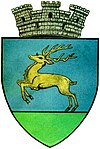Gura Humorului
| Gura Humorului | ||
|---|---|---|
| City | ||

Gura Humorului Town Hall
|
||
|
||
| Location of Gura Humorului | ||
| Coordinates: 47°33′14″N 25°53′21″E / 47.55389°N 25.88917°ECoordinates: 47°33′14″N 25°53′21″E / 47.55389°N 25.88917°E | ||
| Country |
|
|
| County | Suceava County | |
| Status | Town | |
| Government | ||
| • Mayor | Marius Ioan Ursaciuc (Social-Liberal Union) | |
| Area | ||
| • Total | 60.90 km2 (23.51 sq mi) | |
| Population (2011 census) | ||
| • Total |
|
|
| • Density | 209/km2 (540/sq mi) | |
| Time zone | EET (UTC+2) | |
| • Summer (DST) | EEST (UTC+3) | |
| Climate | Dfb | |
| Website | Official site | |
Gura Humorului (Romanian pronunciation: [ˌɡura huˈmoruluj]; Hebrew and Yiddish: גורה חומורולוי - Gur’ Humuruluei or גורא הומאָרא - Gur' Humura; German and Polish: Gura Humora) is a town in Suceava County, north-eastern Romania. It is situated in the historical region of Bukovina. Gura Humorului is the seventh largest urban settlement in the county, with a population of 12,729 inhabitants, according to the 2011 census. It was declared a town in 1904 and it became a resort in 2005. The town administers the former village of Voroneț (which became a neighborhood), site of Voroneț Monastery.
Gura Humorului is located in the north-eastern part of Romania, in southern Bukovina. The town is situated at the eastern limit of Obicinele Bucovinei mountains, in Humorului Depression, at the confluence of Moldova River and Humor River. The average altitude of the town is 470 meters. The European route E58 and the Suceava - Vatra Dornei railway pass through the town. Suceava, the county capital, is located 34 km away. The town of Frasin is located nearby Gura Humorului (only 7 km away).
According to the 1775 Austrian Bukovina census, its population comprised only about 60,000 spread over 10,422 square kilometers. In order to encourage the development of this sparsely-settled land, the authorities subsidized the immigration of colonists to Bukovina. With the end of the first wave of settlement, colonists were to continue arriving at their own expense. As a result of these policies, the census of 1910 showed that the population had risen to over 800,000. People of many different ethnic groups took part in this immigration, including Germans, Rusyns, Hungarians, Ukrainians, Poles, Romanians, and Jews.
...
Wikipedia


